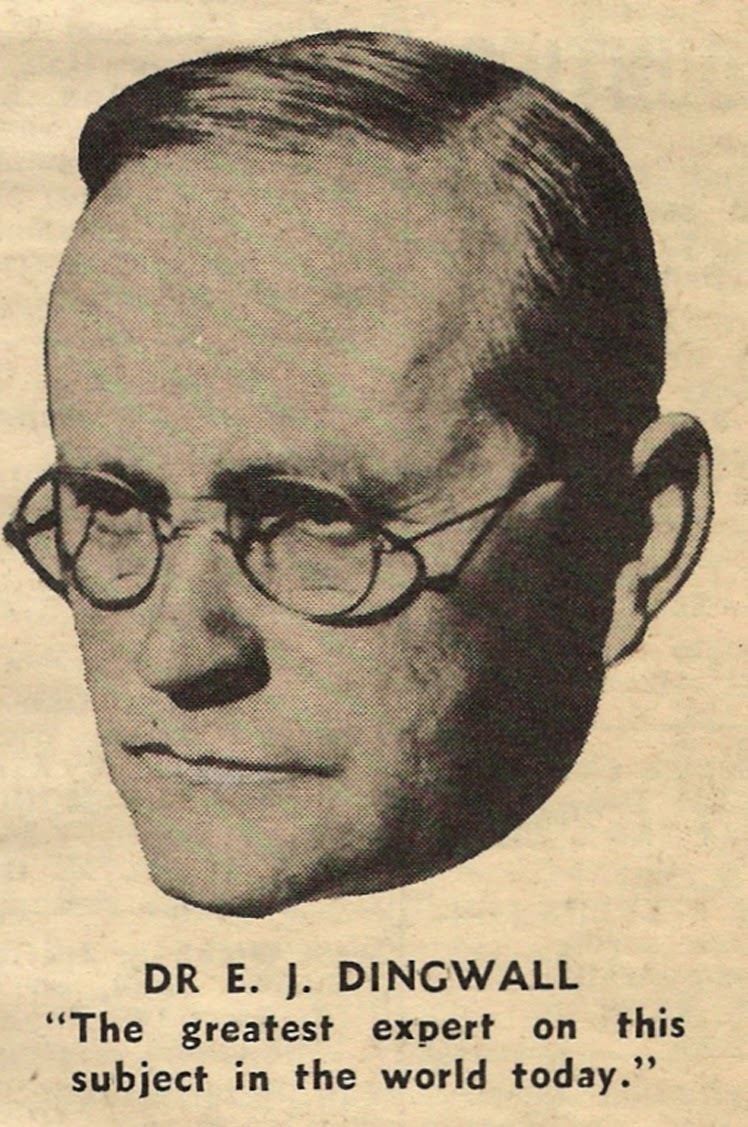Name Eric Dingwall | ||
 | ||
Died 1986, St Leonards-on-Sea, United Kingdom Books The American Woman, How to Go to a Medium, Some Human Oddities, The Girdle of Chastity: A Medico, Ghosts and Spirits in the Ancie | ||
Eric John Dingwall (1890–1986) was a British anthropologist and psychical researcher.
Contents
Biography
Born in British Ceylon he moved to England where he was educated at Pembroke College, Cambridge (M.A., 1912), and the University of London (D.Sc., PhD). He wrote popular books on sexology. He became interested in paranormal phenomena in 1921 and served from 1922 to 1927 as a research officer for the Society for Psychical Research (SPR).
Dingwall was described as an eccentric by those who had known him. From 1947 he worked as an assistant keeper in the British Museum, cataloguing private case material of erotica. He co-edited the four-volume set Abnormal Hypnotic Phenomena (1967–68). The set was described in a review as of considerable historical interest and well written. His book Racial Pride and Prejudice received positive reviews. His books on artificial cranial deformation and infibulation also received positive reviews.
Dingwall was nicknamed "Dirty Ding" due to his interests in erotica and sexual customs.
He was the Honorary vice-president for The Magic Circle and a founding member of its Occult Committee.
He was married twice; firstly to Doris Dunn, an anthropologist and archaeologist (she later married the anthropologist John Layard); and secondly, to the psychologist Dr Norah Margaret Davis.
Psychical research
In the 1920s and 1930s Dingwall travelled widely in Europe and the United States to investigate mediums. He has been described as a "sceptical enquirer" and a psychical investigator who "spent many years exposing fraud and unscientific practices among psychical researchers."
He co-wrote the skeptical book Four Modern Ghosts (1958) with Trevor H. Hall which gave rationalistic explanations for alleged supernatural phenomena such as the Yorkshire Museum Ghost and Harry Price's Rosalie materialization séance. In his book Critics Dilemma (1966), Dingwall supported Hall's criticism of the spiritualist William Crookes and the medium Florence Cook.
He investigated the mediumship of Eusapia Palladino and came to the conclusion she was "vital, vulgar, amorous and a cheat." In 1920, Dingwall with V. J. Woolley tested the medium Eva Carrière in London. The results were negative and it was discovered that her ectoplasm was made from chewed paper.
Dingwall also investigated the medium Mina Crandon. He suspected that she hid her ectoplasm in her vagina but did not come to any definite conclusion. His suspicion was confirmed by the gynecologist Florence Willey.
In his later years Dingwall became a critic of psychical research. In an essay in 1971 he summed up his extensive experience in parapsychological research and came to the conclusion:
His essay The Need for Responsibility in Parapsychology: My Sixty Years in Psychical Research (1971) was reprinted in A Skeptic's Handbook of Parapsychology (1985) by the CSICOP founder Paul Kurtz. The skeptic Gordon Stein dedicated the book The Encyclopedia of the Paranormal to Dingwall.
According to authors William Kalush and Larry Sloman when investigating the medium Mina Crandon; Dingwall told her to take off her clothes and sit in the nude. Crandon would also sometimes sprinkle luminous powder on her breasts and because of such activities William McDougall and other psychical researchers criticised Dingwall for having improper relations with Crandon.
